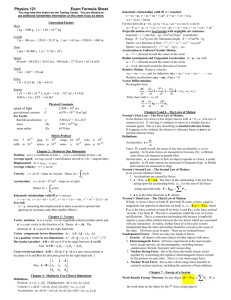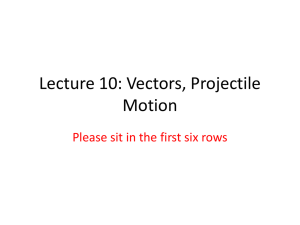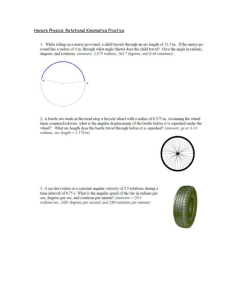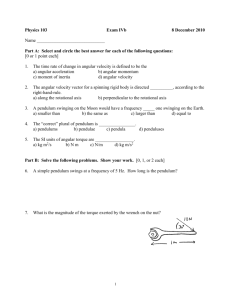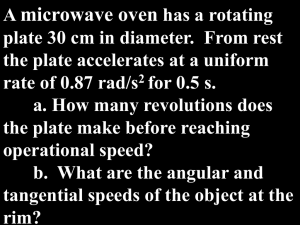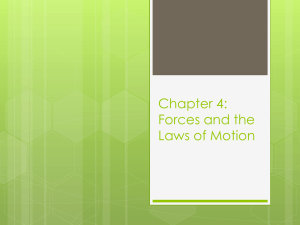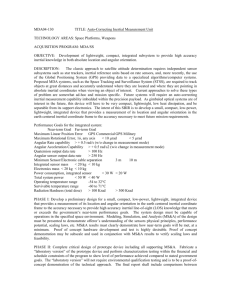Physics 121 Exam Sheet
advertisement
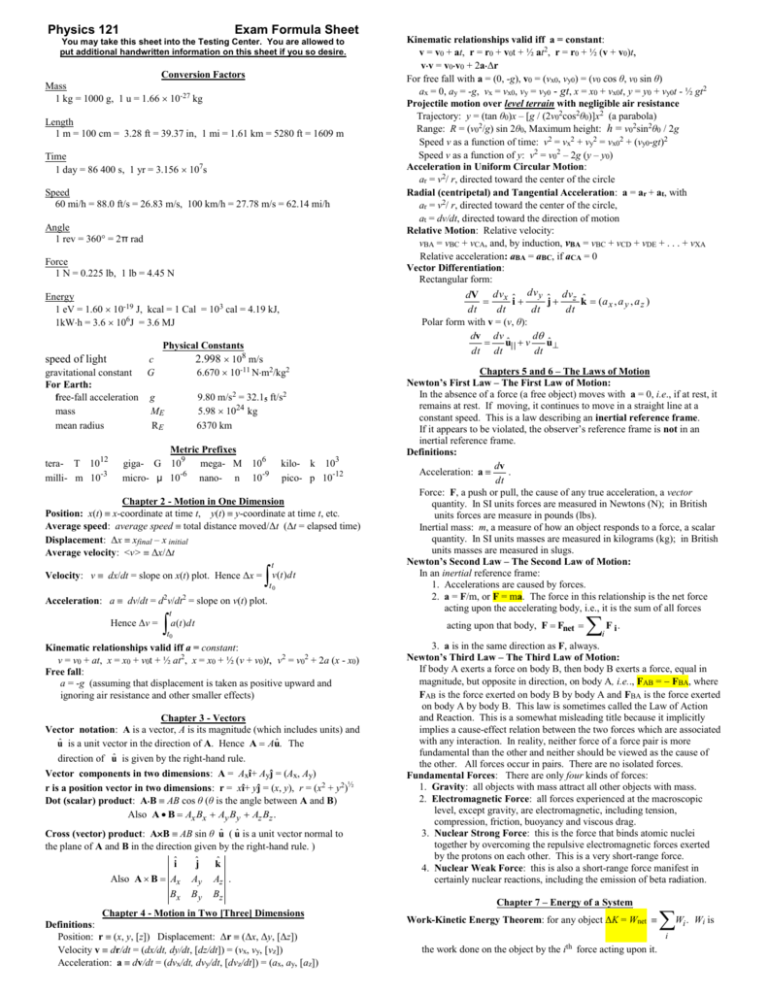
Physics 121 Exam Formula Sheet You may take this sheet into the Testing Center. You are allowed to put additional handwritten information on this sheet if you so desire. Conversion Factors Mass 1 kg = 1000 g, 1 u = 1.66 10-27 kg Length 1 m = 100 cm = 3.28 ft = 39.37 in, 1 mi = 1.61 km = 5280 ft = 1609 m Time 1 day = 86 400 s, 1 yr = 3.156 107s Speed 60 mi/h = 88.0 ft/s = 26.83 m/s, 100 km/h = 27.78 m/s = 62.14 mi/h Angle 1 rev = 360° = 2π rad Force 1 N = 0.225 lb, 1 lb = 4.45 N Energy 1 eV = 1.60 10-19 J, kcal = 1 Cal = 103 cal = 4.19 kJ, 1kWh = 3.6 106J = 3.6 MJ speed of light gravitational constant For Earth: free-fall acceleration mass mean radius tera- T 1012 milli- m 10-3 c G Physical Constants 2.998 108 m/s 6.670 10-11 Nm2/kg2 9.80 m/s2 = 32.15 ft/s2 5.98 1024 kg 6370 km g ME RE Metric Prefixes giga- G 109 mega- M 106 micro- μ 10-6 nano- n 10-9 kilo- k 103 pico- p 10-12 Chapter 2 - Motion in One Dimension Position: x(t) x-coordinate at time t, y(t) y-coordinate at time t, etc. Average speed: average speed total distance moved/Δt (Δt = elapsed time) Displacement: Δx xfinal – x initial Average velocity: <v> Δx/Δt t Velocity: v dx/dt = slope on x(t) plot. Hence Δx = v (t ) dt t0 Acceleration: a dv/dt = d2v/dt2 = slope on v(t) plot. Hence Δv = t a(t )dt Kinematic relationships valid iff a = constant: v = v0 + at, x = x0 + v0t + ½ at2, x = x0 + ½ (v + v0)t, v2 = v02 + 2a (x - x0) Free fall: a = -g (assuming that displacement is taken as positive upward and ignoring air resistance and other smaller effects) Chapter 3 - Vectors Vector notation: A is a vector, A is its magnitude (which includes units) and û is a unit vector in the direction of A. Hence A Aû. The direction of û is given by the right-hand rule. Vector components in two dimensions: A = Axî+ Ayĵ = (Ax, Ay) r is a position vector in two dimensions: r = xî+ yĵ = (x, y), r = (x2 + y2)½ Dot (scalar) product: AB AB cos θ (θ is the angle between A and B) Also A B Ax Bx Ay By Az Bz . Cross (vector) product: AB AB sin θ û ( û is a unit vector normal to the plane of A and B in the direction given by the right-hand rule. ) ˆi ˆj kˆ Bx Ay By Chapters 5 and 6 – The Laws of Motion Newton’s First Law – The First Law of Motion: In the absence of a force (a free object) moves with a = 0, i.e., if at rest, it remains at rest. If moving, it continues to move in a straight line at a constant speed. This is a law describing an inertial reference frame. If it appears to be violated, the observer’s reference frame is not in an inertial reference frame. Definitions: dv Acceleration: a . dt Force: F, a push or pull, the cause of any true acceleration, a vector quantity. In SI units forces are measured in Newtons (N); in British units forces are measure in pounds (lbs). Inertial mass: m, a measure of how an object responds to a force, a scalar quantity. In SI units masses are measured in kilograms (kg); in British units masses are measured in slugs. Newton’s Second Law – The Second Law of Motion: In an inertial reference frame: 1. Accelerations are caused by forces. 2. a = F/m, or F = ma. The force in this relationship is the net force acting upon the accelerating body, i.e., it is the sum of all forces acting upon that body, F Fnet t0 Also A B Ax Kinematic relationships valid iff a = constant: v = v0 + at, r = r0 + v0t + ½ at2, r = r0 + ½ (v + v0)t, vv = v0v0 + 2aΔr For free fall with a = (0, -g), v0 = (vx0, vy0) = (v0 cos θ, v0 sin θ) ax = 0, ay = -g, vx = vx0, vy = vy0 - gt, x = x0 + vx0t, y = y0 + vy0t - ½ gt2 Projectile motion over level terrain with negligible air resistance Trajectory: y = (tan θ0)x – [g / (2v02cos2θ0)]x2 (a parabola) Range: R = (v02/g) sin 2θ0, Maximum height: h = v02sin2θ0 / 2g Speed v as a function of time: v2 = vx2 + vy2 = vx02 + (vy0-gt)2 Speed v as a function of y: v2 = v02 – 2g (y – y0) Acceleration in Uniform Circular Motion: ar = v2/ r, directed toward the center of the circle Radial (centripetal) and Tangential Acceleration: a = ar + at, with ar = v2/ r, directed toward the center of the circle, at = dv/dt, directed toward the direction of motion Relative Motion: Relative velocity: vBA = vBC + vCA, and, by induction, vBA = vBC + vCD + vDE + . . . + vXA Relative acceleration: aBA = aBC, if aCA = 0 Vector Differentiation: Rectangular form: dV dvx ˆ dv y ˆ dvz ˆ i j k (a x , a y , a z ) dt dt dt dt Polar form with v = (v, θ): dv dv d uˆ || v uˆ dt dt dt Az . Bz Chapter 4 - Motion in Two [Three] Dimensions Definitions: Position: r (x, y, [z]) Displacement: Δr (Δx, Δy, [Δz]) Velocity v dr/dt = (dx/dt, dy/dt, [dz/dt]) = (vx, vy, [vz]) Acceleration: a dv/dt = (dvx/dt, dvy/dt, [dvz/dt]) = (ax, ay, [az]) F . i i 3. a is in the same direction as F, always. Newton’s Third Law – The Third Law of Motion: If body A exerts a force on body B, then body B exerts a force, equal in magnitude, but opposite in direction, on body A, i.e.., FAB = FBA, where FAB is the force exerted on body B by body A and FBA is the force exerted on body A by body B. This law is sometimes called the Law of Action and Reaction. This is a somewhat misleading title because it implicitly implies a cause-effect relation between the two forces which are associated with any interaction. In reality, neither force of a force pair is more fundamental than the other and neither should be viewed as the cause of the other. All forces occur in pairs. There are no isolated forces. Fundamental Forces: There are only four kinds of forces: 1. Gravity: all objects with mass attract all other objects with mass. 2. Electromagnetic Force: all forces experienced at the macroscopic level, except gravity, are electromagnetic, including tension, compression, friction, buoyancy and viscous drag. 3. Nuclear Strong Force: this is the force that binds atomic nuclei together by overcoming the repulsive electromagnetic forces exerted by the protons on each other. This is a very short-range force. 4. Nuclear Weak Force: this is also a short-range force manifest in certainly nuclear reactions, including the emission of beta radiation. Chapter 7 – Energy of a System Work-Kinetic Energy Theorem: for any object ΔK = Wnet W . W is i i the work done on the object by the ith force acting upon it. i Definitions: ΔK Kfinal Kinitial Wi (The integral forms of these equations are the impulse-momentum theorems.) Center of mass: ½ mvf2 ½ mvi2 N rf Fi dr , Wi is the work done by any force Fi in a displacement ri rf F ri net dr W F dr, where F rf i i i ri net i F. i i i i for discrete particles. e.g., Wg mg( y f yi ) for Fg mg ˆj 2. One-dimensional motion: W int kineticenergy potentialenergy int ernalenergy Potential Energy: U g mgy for Fg -mgˆj. (near - earth gravity), 1 2 kx for FH kx ˆi (Hooke's law) , 2 k k U for F rˆ (long - range gravity and electrostatic forces) r r2 UH For gravity k = GMm for electrostatic force k = kCQ. U Force from a radial potential energy: Fr rˆ . r Chapter 9 – Linear Momentum and Collisions Conservation of Momentum: dP For an isolated system (Fext = 0) Pf Pi , or P 0, or 0. dt Definition of momentum: pp For a particle p mv K , 2m For a system ptotal = Σ pi = Σ mivi = Mvcm, where M Σ mi mv mv M m i i i i i 1 2 I for a rotatingrigid body 2 2 p total 2M d d 2 s s d , , , dt r r dt dt 2 θ v2 s r , v r , a tan r , a radial r 2 v r The translational kinematic and dynamic relationships of other chapters hold for these variables if we identify t↔t, x↔θ, v↔ω, a↔α, m↔I, F↔τ, p↔L, K↔K, k↔κ, W↔W, e.g., Newton’s 2nd Law: F = ma ↔ τ = Iα Angular units: 1 rev = 360° = 2π rad 1 For constant angular velocity, f , with f [cyc/s],T [s], [rad/s] T 2 Rotational Inertia: General definition: I mr 2 i (particles), i r 2 dm (object) Parallel-axis theorem: I = Icm+ Md 2 Specific uniform bodies: 2 Solid sphere about a diameter: I 2 Sph. shell about a diameter: I 3 5 MR MR 2 2 Solid cyl abt centered diam: I Hoop or cyl shell about sym axis: I MR Hollow cyl about sym axis: I 1 M (R 2 2 2 1 4 MR 2 Law of Motion and the Impulse-Momentum Theorem: dp particle: F Fnet p Fdt I. dt dP system: Ma CM Fext P Fext dt dt I R 1 2 Rectangular plate abt axis through center: I 1 12 M (a 2 2 1 12 1 12 ) “, abt axis thru an end: I 2 1 3 MR 2 2 ML MR 2 MR 2 2 b ) Rolling (for a object of cylindrical symmetry, rolling without slipping): 1 1 2 and K I CM 2 MvCM vcenter R 2 2 Chapter 11 – Torque and Angular Momentum Conservation of Angular Momentum: dL For an isolated system (τext = 0) L f L i , or L 0, or 0. dt Second Law of Motion: Definition of torque: τ r F dL particle: τ τ net L τ dt. dt dL system: τ ext L τ ext dt. dt (The integral forms of these equations are the angular impulse-momentum theorems.) Definition of angular momentum: L r p r mv for a particle. L L i i (R P) L CM (R MV) L CM for a system F 0 , (2) τ 0 For coplanar forces: (1a) F 0, (1b) F (2a) 0. Vector format: (1) Ext Ext x, Ext z ,Ext ext . 2 Thin rod, abt centered axis: I Two equilibrium conditions: unless the system consists of a 1 Solid cylinder about symmetry axis: I Chapter 12 – Static Equilibrium, Elasticity nd i Iα, where τ i ri Fi .) single particle or object.) i L Iω for a rigid body rotatingabout a principalaxis i i i (Warning: Ktotal is not usually equal to τ Angular variables: [rad] functionof rest mass, temperatu re, physical 1 1 K m v2 mv v, U int m c2 state, chemical state and nuclear structure 2 2 Conservative force: is a force which does not change the total mechanical energy of a system when it does work on the system. i.e., K U 0 as a consequence of work done on a system by such a force. For a conservative force the associated potential energy can be defined by r U ˆ for a one- dimensional U Wc Fc dr and thereforeFc U (r ) i force. r x (Hence vCM Chapter 10 – Rigid-body, Fixed-axis Rotation Dynamics: Kinematics: Fx dx. 1 e.g., WH k ( xv2 xi2 ) for FH kx ˆi. (Hooke's law) . 2 3. W = 0, if F r . Power: lim W P F v. t o t Chapter 8 - Conservation of Energy If a physical quantity X is conserved for an isolated system, then dX X 0 or X final X initial or X constant or 0. dt Conservation of Energy: dE For an isolated system: E 0 or E final Einitial or 0. dt Definitions: K U U r dm for continuoussystems. Kinetic energy: K xf xi M rCM Equation of motion: τ net Special Cases: 1. F = constant: w F d F r , E m r i 1 from ri to r f. If Fi is (is not) conservative, the integral and therefore Wi does not (does) depend upon the path taken in evaluating the integral. Wnet M rCM y,Ext 0, s r s Equation of Motion: If (1) and (2) above are true are true about one inertial reference point, they are true for all inertial reference points. 2 N m g r i i i for discrete particles. i 1 Mg CG rCG 2 dx 2 x 0, or 2 x 2 2 A 2 dt dt Leads to SHM with ω2 = (angular frequency) 2. d 2x Center of Gravity: MgCG rCG Any equation of either of the forms Hooke’s Law: r gdm for continuoussystems. Note that if g is constant across the mass distribution (or varies negligibly) then rCG = (or ) rCM. Chapter 13 Universal Gravitation Law of Universal Gravitation: m m F21 G 1 2 (rˆ12 ) where F21 is the force exerted by m2 on m1, r̂12 is a r2 unit vector directed from m2 towards m1, i.e., the force is attractive, and If Fx = -kx, then, by Newton’s third law, a d 2x dt 2 This is the equation of SHM with k x. m k m 1 1 , T 2 and f m k T 2 2 k . m kg This expression is valid for point masses and also for symmetric spheres (r being the center-to-center separation). Where more than two masses are present, the net force on any particular mass is obtained by simple 1 2 kA U K . 2 1 1 The potential energy is U kx 2 kA2 cos2 (t ). 2 2 1 1 2 2 The kinetic energy is K mv kA sin 2 (t ). 2 2 superposition, i.e., Fj,net Fj1 Fj2 Fj3 . . . . The angular analogue of Hooke’s law is , which leads to G 6.674 1011 N.m2 2 2 N.m2 1010 is theuniversalgravitational constant. 3 kg2 i,i j F ji . Astrophysical consequences: g of earth Kepler’s Laws of planetary motion: (1) elliptical (conic section) orbits, 4 2 dA a 3 K a 3 (2) constant , or L = constant, (3) T 2 S GM S dt Motion in binary star systems Large-scale cosmic structure Gravitational potential energy: Gm1m2 . Note that U (r = ) = 0. Ug r Bound and unbound orbits. vesc 2GM . Superposition applies. R Gravitational field: Fg g [m/s2 N/kg] . m Gravitaional mass versus inertial mass: mia = mgg, or a mg mi g . Any departure of a from g (in a vacuum) would imply the two are different. Experiment verifies that any difference must be <1 part in 10 11. Chapter 15 Oscillatory Motion Kinematics: Any of the following forms (all of which can be shown to be equivalent) describes oscillatory, or simple harmonic motion (SHM): x(t ) A cos(t ), or x(t ) B sin(t ), or x(t ) C cost D sin t. Note that each of the above expressions contains two unspecified constants: (A, φ), (B, ψ) or (C, D). These are determined by the initial conditions x(t0) dx . and dt t t 0 (We shall use the first of the above forms, an arbitrary choice, not necessarily a best choice.) The first form, in words, is (x at time t) = (amplitude)cos[(angular frequency)t + phase constant)] Since x(t) = A cos (ωt + φ), it follows that v(t ) a(t) dx(t ) A sin (t ), dt dv d 2 x A 2 cos (t ) 2 x(t ), and therefore dt dt 2 2 x 2 v 2 w2 A2 ω(angular frequency) = 2π f (frequency) = 2π /T (period) The total energy is E d 2 dt 2 I , again the equation of SHM, this time with I . The generality of SHM: Almost all small departures from stable equilibrium exhibit SHM.
